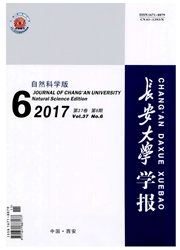

 中文摘要:
中文摘要:
基频是连续梁的重要参数之一,在结构动力响应、抗震设计、冲击系数及共振分析等方面具有重要的理论意义。针对《公路桥梁设计通用规范》(JTG D60—2015)中连续梁基频公式近似计算结果与实际偏差较大的问题,研究常规等截面及大跨径变截面连续梁基频的近似计算问题,依托结构动力学基本特征方程推导出连续梁基频的近似计算公式,将结构参数的常见变化范围进行整理并各自均匀提取若干数值作为参数样本,计算中不考虑剪切变形及横隔板、齿板等细部构造的影响,将所有参数样本全排列得到10万余座不同参数的桥梁样本,实现常见参数连续梁“全覆盖”。利用APDL编程语言对ANSYS进行二次开发,结合工作站的强大计算能力,批量计算10万余座桥梁样本的理论基频,最终对连续梁基频近似计算公式的形式进行理论分析,结合1stopt与MATLAB软件对各种可能的计算公式进行非线性拟合,直至得出形式简明、计算精度高的最佳基频近似计算公式。研究结果表明:连续梁基频的近似计算公式和有限元计算值最大误差为2.1%,平均绝对值误差为0.3%,判定系数R2均大于0.9999,近似程度良好。经实际工程验证,可快速准确地对连续梁基频进行估算、验算。
 英文摘要:
英文摘要:
Fundamental frequency is one of the most important parameters for continuous beams, which has important theoretical significance in several aspects, such as structural dynamic response, seismic design, impact factor and resonance analysis. Aiming at the obvious deviation between "General Code for Design of Highway Bridges and Culverts" (JTG D60-2015) and actual structure in fundamental frequency calculation, approximate fundamental frequency calculation for both normal cross-section and long-span variable cross-section continuous beams were studied. Approximate calculation formula of fundamental frequency for continuous beams was derived based on structural dynamic equations. Common range data of structural parameters were handled and uniformly recovered to be parameters sample. A series of simplification were carried out during the analysis, for example, the influences of structure details such as shear deformation, horizontal clapboard and tooth plate were ignored. A sample of more than 100 thousand continuous beams with uniform section and variable section was analyzed, of which structural parameters cover all common parameters of continuous beam. Then the fundamental frequency of the sample was batch computed after APDL program language's secondary development based on ANSYS and competitive computation power of work station. Finally, the theoretical analysis was conducted to the form of approximate calculation formula of fundamental frequency of continuous beam. In addition, the optimal practical formulas with concise form and high calculation accuracy were obtained by nonlinear fitting all kinds of possible calculation formulas through lstopt and MATLAB. The results show that the maximum deviation from finite element calculation result to presented formulas result is 2.1%, the average absolute deviation is 0.3%, and the determination coefficient R2 exceeds 0. 999 9, which proves that the formulas coincide well with the facts. Through practical engineering verification, the practical formulas can es
 同期刊论文项目
同期刊论文项目
 同项目期刊论文
同项目期刊论文
 期刊信息
期刊信息
